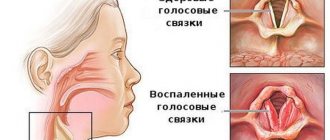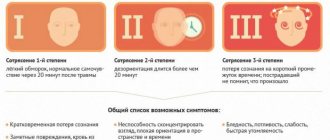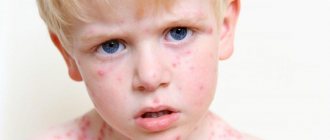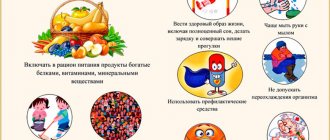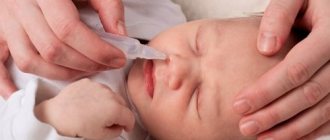ARVI occurs more often in infants than in older children.
The reason is the baby’s immature immune system, which makes his body especially susceptible to viruses and bacteria. If symptoms of ARVI appear in an infant, you should consult a specialist and begin treatment. It is impossible to treat a viral disease on your own, since due to the age of newborns, not all medications are allowed.
Symptoms
In the early stages of infection, the virus, which entered the body through the nasopharynx, causes inflammation of the nasal passages and larynx, a dry cough, sore throat, and runny nose appear.
The temperature does not rise immediately, but only after the virus enters the blood. This stage is characterized by chills, fever, and a feeling of aching throughout the body, especially in the limbs. At the final stage of the acute respiratory viral infection, the affected airways are cleared, the cough becomes wet, and the cells of the epithelium affected by the viral agent are expelled with sputum. It is at this stage that a secondary bacterial infection can begin, since the affected mucous membranes against the background of reduced immunity create very favorable conditions for the existence and reproduction of pathogenic bacteria and fungi. This can cause rhinitis, tracheitis, tonsillitis, meningitis.
There is a special table of differences that will help parents at least approximately understand which agent they are dealing with.
| Manifestations of the disease | Influenza virus (strains A and B) | Parainfluenza virus | Adenovirus | Respiratory syncytial virus |
| Beginning (first 36 hours) | Sharp, sharp and heavy | Acute | Gradual with transition to acute | Acute |
| Body temperature | 39.0-40.0 and above | 36,6 — 37,5 | 38,0-39,0 | 37,0-38,0 |
| Duration of fever | 3-6 days | 2-4 days | Up to 10 days with alternating decrease and increase in fever | 3-7 days |
| Intoxication | Strongly expressed | Absent | Smoothly increases, but overall quite moderate | Weak or absent at all |
| Cough | Unproductive dry, accompanied by chest pain | Dry, “barking” dry, hoarseness, hoarseness | Wet cough, the intensity of which increases gradually | Unproductive dry, breathing difficult |
| The lymph nodes | Increases with complications of influenza | Slightly increased | Noticeably enlarged, especially the cervical and submandibular | Virtually no increase |
| Airway condition | Runny nose, | Severe rhinitis, difficulty breathing | Inflammation of the mucous membranes of the eyes, severe runny nose | |
| Possible complications | Hemorrhagic, hemorrhage into internal organs, myocarditis, damage to the central nervous system and peripheral nervous system. | Developmental strangulation | Bronchitis, bronchopneumonia, pneumonia, development of bronchial asthma |
against bacterial infections at home is quite difficult, so laboratory diagnostics will come to the aid of parents.
Traditional treatment prescribed to a child by a pediatrician is based on the use of antiviral drugs. Symptomatic treatment is also provided: for a runny nose - nasal drops, for a sore throat - rinses and sprays, for coughs - expectorants.
Complications after ARVI in a child
Unfortunately, an acute respiratory viral infection does not go away without leaving a trace. Newborns may have specific and nonspecific complications.
Specific
The first category includes the following problems:
- Febrile seizures. From time to time, the baby will be bothered by spasms in the joints of the lower and upper extremities. The phenomenon is short-term and goes away after the symptoms of ARVI are completely eliminated;
- Reye's syndrome;
- Chronical bronchitis. Against the background of influenza or parainfluenza, a specific complication develops in the form of damage to the bronchial system. For 3-5 months, the child will be bothered by a dry cough without sputum. Complex therapy is required to eliminate this problem;
- Deviations in heart rhythm. Among all complications, tachycardia or bradycardia is clearly manifested, especially in premature infants;
- Hemolytic-uremic syndrome.
All complications of a specific type can be corrected and treated. Often, these manifestations occur on a short-term basis.
Nonspecific
Let's consider nonspecific complications called an acute form of a respiratory virus:
- Bronchial asthma. Against the background of a developed ARVI, problems with the respiratory system arise, which in the future become chronic.
- Tuberculosis. Respiratory viruses cause significant damage to the lungs, resulting in the formation of dark spots on the paired organs.
- Problems with the urinary tract.
Nonspecific manifestations are much more difficult to cure. To prevent this situation, it is recommended to carry out timely diagnosis, examination by a pediatrician and treatment.
Possible complications
Acute upper respiratory tract infection in an infant sometimes causes complications. These include:
- hemorrhagic syndrome;
- neurotoxicosis;
- meningoencephalitis;
- myocarditis;
- bronchitis;
- pulmonary edema;
- pneumonia;
- acute glomerulonephritis.
A complication of high fever is severe dehydration of the child’s body, resulting in the development of convulsive syndrome. This condition can be fatal.
Treatment of ARVI in children of early and middle age
It is important not only to know all the necessary symptoms of the disease, but also to correctly treat acute respiratory infections in children. Most often, treatment of acute respiratory infections in children consists of impeccable adherence to bed rest.
In the process of fighting the virus, the body (and especially a fragile child’s body) should be in a state of complete rest. Influenza and acute respiratory viral infections with manifestations of an active lifestyle threaten the child with serious complications. Children usually tolerate such immobilized bed rest more easily if they are constantly in contact with adults.
Treatment of ARVI in children under one year of age should always proceed under the close supervision of the attending physician. At such an early age, children are contraindicated from taking potent medications that have a rapid therapeutic effect on the child’s body. Be prepared for the fact that treatment may take more than one week, but with proper adherence to bed rest and a series of medical consultations, it will end successfully.
Treatment of ARVI and influenza in preschool children and primary school students is made easier by the fact that at this age the child can be given more potent medications. Be careful when taking antibiotics. Antibiotics for ARVI in children are indicated only in very extreme cases of serious illness, and then only as prescribed by the attending physician. When purchasing medications at a pharmacy, always check how strong the medications you are purchasing are, and also make sure that they do not contain antibiotics.
The incubation period for ARVI in children usually lasts from 2 to 4 days. At this time, the disease is in its infancy and is quite difficult to detect. During the incubation period, the child may not even suspect that he is sick, but feel well, already being, in fact, a carrier of infection. There are rare cases when the incubation period of the disease is accompanied by any characteristic symptoms (weakness, a runny nose), however, if you are lucky and you were able to identify the disease before it became active, treatment of acute respiratory infections may require several days or more.
The fight against the virus can also occur by strengthening children's immunity. To do this, during the treatment period, the child must be given enough natural products that contain ascorbic acid (vitamin C). This useful microelement is found in abundance in a number of citrus fruits, sorrel, broccoli, spinach, hazelnuts and walnuts. Medicines for ARVI are an integral part of the procedure for ridding the child’s body of viruses, but during the treatment process it is also necessary to provide a supportive effect, expressed in taking vitamins.
Incubation period in adults
The incubation period for acute respiratory infections in adults reaches 14 days. Symptoms appear immediately or occur gradually. Sometimes the body copes on its own before the first signs appear, and the disease does not occur. During this period, a person may feel a little worse, and weakness appears.
During the incubation period of acute respiratory infections and acute respiratory viral infections in adults, it is not advisable to use medications for treatment. You can only use products to support your immune system. Hypothermia and stress contribute to the development of the disease. In winter, you should not get too cold and avoid crowds of people.
Diagnosis of acute respiratory infections
The diagnosis is made based on the patient's complaints and examination data. On examination, as a rule, hyperemia of the mucous membranes of the throat is revealed.
It is important to differentiate the “common” cold from the flu, since the effectiveness of treatment depends on the correct diagnosis
In this case, it is important to pay attention to such pathognomonic (characteristic) symptoms of influenza as eye pain and photophobia. Rhinovirus infection mainly affects the epithelium of the nasal mucosa, and adenoviruses – the palatine tonsils and pharynx. Parainfluenza is characterized by inflammation of the laryngeal mucosa
Parainfluenza is characterized by inflammation of the laryngeal mucosa.
Important: It should be borne in mind that even during a flu pandemic, the patient may well suffer from a bacterial infection. An epidemic is not a basis for prescribing antiviral drugs to all patients with malaise and respiratory symptoms without exception.
Why are antihistamines prescribed for colds?
Sometimes doctors prescribe Suprastin for children with ARVI. Antihistamines must be taken in order to improve the baby’s well-being. In the presence of a viral infection, swelling of the tissues, mucous membranes of the nose and oropharynx may develop. It is these manifestations that suprastin reduces in ARVI.
In addition to facilitating breathing, the drugs help improve the process of falling asleep and staying asleep, and relieve the active cough reflex.
Cough, vomiting and other symptoms of acute respiratory infections
Very often, symptoms of acute respiratory infections in children can manifest themselves in the presence of cough, vomiting and diarrhea. This is due to the fact that the child’s immune system, in the process of fighting the virus, tries to remove its breakdown products from the body by any available means. Cough during acute respiratory infections in children almost always has a wet, productive nature and is accompanied by sputum production. If such a cough is present, it should not be heavily healed, since the child’s body needs to remove the products of the disease from the body. Parents can ease coughing attacks by giving their child plenty of warm tea and milk, or by taking cough syrups for children.
Vomiting during ARVI in a child is often fleeting and is the body’s reaction to food intake. Be prepared for the fact that a sick child will refuse to eat. This is a completely normal phenomenon, in which you should not insist on eating. During illness, it is enough for the body to take food only a few times a day and then in small quantities. Thus, it generates more energy to fight the virus rather than to the process of digesting food.
Diarrhea during ARVI occurs for the same reasons as childhood vomiting and is a consequence of the fact that some bacteria have reached the child’s gastrointestinal tract. Attacks of diarrhea will stop as the disease is treated, and in order to make a child’s life a little easier, you can resort to taking special medications that maintain normal intestinal microflora. If attacks of diarrhea do not go away as the illness subsides, it is necessary to show the child to a doctor; perhaps the causes of diarrhea do not lie in the child’s acute respiratory infection, but have other roots.
Preparations for symptomatic treatment and first aid
What to give a child for ARVI should be decided by the doctor, who should be invited immediately after the first signs of a viral infection appear in the baby.
All drugs must be purchased in children's dosage forms, and given to the child strictly according to the schedule and dosage recommended by the doctor.
From temperature
Temperature is a normal reaction of the body to an invading virus. Under its influence, the process of producing interferons is launched; these substances do not allow viruses to penetrate the cells of the human body and multiply there.
We recommend reading: Cefotaxime for children
Thermometer readings up to 38 degrees should not cause concern to parents; they can not be reduced by medications (provided that the child does not have diseases for which high body temperature is contraindicated).
To combat higher numbers, you can use syrups or suppositories for ARVI in children. These drugs may contain ibuprofen or paracetamol as active ingredients, as well as their combination (Panadol, Nurofen, Cefekon). These drugs are considered safe for the baby; they gently reduce elevated body temperature, simultaneously relieving him of headaches, as well as ear pain, which often accompanies otitis media.
Children should not be given aspirin to lower their temperature. This medicine can cause serious side effects such as internal bleeding.
The instructions included with the drugs indicate specific dosage numbers that must be followed. You should not give the same drug throughout the day; it is better to alternate the active ingredients, observing a time interval between their doses of 4 to 6 hours.
For a runny nose
For a runny nose and cough caused by mucus flowing down the back wall of the larynx, special syrups and lozenges can help.
To make the treatment process faster, you need to:
- rinse the nasal cavity with saline solutions, for example, containing sea water (Aqualor, Salin, Aquamaris), use self-prepared formulations;
- before going to bed, to facilitate nasal breathing, you can use drops that have the ability to narrow the dilated vessels of the nose (Nazivin, Otrivin, Snoop);
- To fight colds, when the snot changes its hue to yellow or green, you can use Pinosol, Sialor. These drugs have the ability to fight bacteria, which allows you to quickly get rid of unpleasant nasal flow. According to the doctor's recommendation, the child can be instilled with Isofra drops.
Important! Drops used to constrict blood vessels cannot be used for a long time. Already after 5-6 days, addiction to the active substance may develop, which is fraught with serious complications.
Against cough
Cough is a frequent accompaniment of acute respiratory infections; as a rule, in the first days it is dry, which causes serious discomfort to the child, causing discomfort in the larynx.
To prevent this symptom from bothering the child, you need to make the cough productive, to ensure that it passes into the wet stage, with sputum production. For this purpose, you can use syrups with a plant base (Gerbion, Doctor Mom), Mucaltin tablets, inhalations with Bromhexine, saline or alkaline mineral water.
Pulmicort for inhalation or offer drugs that suppress the cough reflex (Sinekod) to a child without a doctor’s prescription.
Helping your child with a sore throat
Unpleasant sensations in the throat often develop in children when a viral infection occurs. To alleviate the condition of the baby, you can use the following methods of therapy:
- spray Miramistin for ARVI in children: the drug destroys infections well;
- rinse your mouth with decoctions of chamomile, sage, and calendula. You can use a mixture of soda and salt for this purpose;
- irrigate the throat with Hexoral, Ingalipt, Tantum Verde sprays;
- if the child’s age allows, dissolve Faringosept.
We recommend reading: Influenza Virus
For vomiting and diarrhea from intoxication
In some cases, an enterovirus may be associated with a respiratory infection, causing nausea and digestive disorders. In addition, such symptoms accompany severe intoxication of the body.
To prevent dehydration, it is very important to follow these rules:
- Be sure to give your child enough water;
- give him rehydration solutions (Humana Electrolyte);
- You can offer Polysorb for children with ARVI, Smecta helps a lot;
- sometimes enterosorbents (Enterosgel) are required;
- if there are signs of a bacterial infection, the doctor may prescribe Enterofuril, which destroys microbes in the intestines.
Children should not be offered medications containing loperamide to prevent diarrhea.
For conjunctivitis
Among the first symptoms of a viral infection, redness of the eyes, active flow of tears from them, and the appearance of purulent discharge often occur. These signs cannot be ignored; they indicate the development of viral conjunctivitis.
Only a doctor can prescribe proper treatment, because the disease can be of different nature: allergic, bacterial or viral. Accordingly, the treatment will be indicated differently.
For first aid for a child, you can use Tobrex drops or Ophthalmoferon ointment.
Antiviral drugs
Antiviral drugs, actively advertised and often prescribed to children, most often do not give a visible effect and are a simple waste of money.
Anti-flu syrup, chosen independently, may not only not help, but also harm the baby. Especially if my mother bought it without first consulting a doctor.
Most drugs prescribed to fight viruses have the ability to increase the amount of interferons in the human body (suppositories Viferon, Kipferon, Grippferon drops). Their thoughtless use can greatly harm human health by disrupting the process of producing one’s own protective antibodies.
Among antiviral medications, homeopathic remedies (Ocillococcinum, Aflubin) are especially often prescribed to children; most often, they do not harm the child’s body, but they do not bring any benefit either.
Efficiency proven by scientific research is found only in such serious drugs as Tamiflu and Oseltamivir. However, their independent administration is not allowed, especially when the child has ARVI. These antiviral, anti-influenza drugs for children can only be recommended by a doctor, accurately recommending the dosage.
Children's syrup for ARVI and influenza can only be prescribed by a specialist with the appropriate qualifications.
What other dangerous diseases can be transmitted to humans from chickens?
Bird flu is not the only disease that is transmitted from indoors to people. Chicken breeders should also be wary of infectious diseases such as:
- Pullorosis (typhoid). The birds lose their appetite, diarrhea begins, and their comb and earrings turn pale. The virus can be transmitted through meat and eggs.
- Colibacillosis. The chicken becomes lethargic, thirsty, and begins to choke.
- Pasteurellosis (bird cholera). Chickens suffer from extreme thirst, fever and bloody diarrhea. When infected, the disease in humans occurs in an acute form.
- Newcastle disease. The gastrointestinal tract, nervous system and respiratory organs are affected. To avoid an epidemic, it is recommended to burn such chicken or bury it deeply, covering it with quicklime.
- Salmonellosis (paratyphoid fever). The infection reveals itself as liquid, foamy stool, inflammation of the cloaca, and sticking of the eyes. Salmonella bacteria are very dangerous, contagious and tenacious.
Your health and the health of the “poultry yard” can be preserved. You just need to adhere to preventive measures. Keep your chickens clean, show them to a veterinarian, and feed them a well-processed diet. If you suspect bird flu, contact your doctor or veterinarian.
Symptoms and signs of acute respiratory infections in children
The nature of the course of acute respiratory infections in children directly depends on the age of the child. Thus, in a child infected from his mother, the course of clinical symptoms is usually more severe and acute.
The most common manifestations of acute respiratory infections in children include rhinitis, discomfort in the throat when swallowing and speaking, cough of various types, signs of intoxication and fever.
Emergency situations that require immediate correction by a pediatrician include the appearance in a child of unmotivated weakness, intense headache and muscle stiffness, weakened sucking reflex, star-shaped hemorrhagic rash, multiple episodes of vomiting, decreased daily diuresis and increased dryness of the skin, signs of ear inflammation , barking cough, increased body temperature exceeding 39°C.
The clinical picture of acute respiratory infections in children consists of symptoms of general intoxication, occurring in varying degrees of intensity, and damage to the structures of the respiratory tract. Clinical diagnosis of the etiopathogenesis of acute respiratory infections in children is extremely difficult, since in each child the course of one or another etiopathogenetic form of this disease can differ significantly.
When examining a patient and establishing a diagnosis of acute respiratory infections in children, it is mandatory to indicate the symptom complex of damage to the respiratory tract organs, the nature of the course of the disease, the severity and presence of complications of acute respiratory infections in children.
Symptom complexes of damage to the structures of the respiratory tract include various variants of inflammatory changes in the form of rhinitis, pharyngitis, laryngitis, tracheitis, bronchitis, bronchiolitis, which are most often combined with each other and are extremely rarely observed in isolated form. Acute respiratory infections in children are characterized by the manifestation of only the acute form of bronchitis.
When determining the etiopathogenetic form of acute respiratory infections in children, it should be taken into account that each pathogen of this disease with particular selectivity affects the structures of the respiratory tract. Rhinoviral acute respiratory infections in children predominantly affects the epithelial cells of the nasal cavity, which manifests itself in the form of symptoms of rhinitis (difficulty in nasal breathing, the presence of copious mucous discharge from the nasal passages, unpleasant sensations in the nasal cavity in the form of a burning sensation).
Adenoviral acute respiratory infections in children are characterized by inflammatory lesions of the lymphopharyngeal ring and conjunctiva, which occurs with a pronounced exudative component. The predominant localization of inflammatory changes in parainfluenza acute respiratory infections in children is the larynx, so laryngitis comes first in the clinic. Respiratory syncytial acute respiratory disease in children is characterized by the appearance of inflammatory changes in the lower parts of the respiratory tract with the development of bronchitis symptoms.
The severity of intoxication manifestations also directly depends on the specificity of the causative agent of acute respiratory infections in children. The most pronounced intoxication syndrome is characterized by influenza acute respiratory infections in children, manifested by a maximum increase in body temperature exceeding 39–40°C. With a complicated course of acute respiratory infections, children develop multi-wave fever. An increase in skin temperature during acute respiratory infections in children most often manifests itself as chills, intense headache, localized mainly in the forehead.
Intoxication manifestations in parainfluenza acute respiratory syndrome in children are minimal, and the course of the disease is usually gradual. Adenoviral acute respiratory infections in children, which most often proceed favorably, are characterized by a similar intensity of intoxication manifestations. Rhinoviral acute respiratory infections in children occur without any increase in body temperature, therefore this etiopathogenetic form is considered as the most favorable in terms of its impact on the child’s health. Acute respiratory infections in children, provoked by exposure to mycoplasmas, are characterized by a gradual onset of clinical manifestations and, at the same time, their prolonged course. Diarrhea due to acute respiratory infections in a child is observed, as a rule, with enteroviral etiology, and can also be observed against the background of a sharp increase in body temperature.
Complications of acute respiratory infections in children most often manifest themselves as the development of infectious-toxic shock with the development of acute cardiovascular failure, pulmonary edema and cerebral edema, and disseminated intravascular coagulation syndrome. The most common variant of the complicated course of acute respiratory infections in children is the development of viral or bacterial pneumonia.
With regard to the laboratory signs of acute respiratory infections in children, there are differences: with viral etiology, lymphocytosis and a tendency to leukopenia are observed, while with bacterial origin, on the contrary, neutrophilia is observed with a shift in the leukocyte formula to the left.
Prevention of ARVI in children
An acute respiratory viral infection, as the name suggests, is transmitted by airborne droplets, so the prevention of ARVI in children consists of limiting their contact with people who carry this disease. Typically, a child can catch the virus by playing with children in the yard, or by contact with his or her kindergarten group or class. And if in educational and educational institutions the task of identifying carriers of the disease falls on the staff, then while walking with children in the yard, you yourself must control the process of communication between the child and his peers. Have an educational conversation with your child and explain to him why you should not play with children who have a cough or runny nose.
Prevention of acute respiratory infections in children also consists of following the necessary vitamin diet, as well as systematic exercise. Make sure that your child leads an active lifestyle, but at the same time is reliably protected from the wind and the possibility of catching a cold. If you are unable to buy products containing vitamins in sufficient quantities, contact a pharmacy for help and buy your child a vitamin-mineral complex in capsules. So, you can simplify the procedure for enriching the child’s body with essential microelements, reducing it to taking vitamins in capsules several times a day. It is better to prevent rather than treat a disease, so make sure that your child takes enough vitamins if you do not want him to subsequently be forced to take antibiotics for children with ARVI.
Prevention of the disease also involves constant monitoring by the attending physician. A competent pediatrician can not only suggest how to treat acute respiratory infections, but also give some practical advice regarding some important nuances in the treatment of the disease. The correct approach to the treatment of acute respiratory viral infection, as well as a range of knowledge regarding its symptoms, will help you react faster if the disease affects your child. Remember that a viral infection always requires proper attention and proper treatment. How long ARVI will last in a child will depend only on your correct and timely actions.
Should you take antibiotics for colds or not?
Some parents are of the opinion that in order to quickly get their child back on his feet, it is necessary to take antibacterial drugs that they themselves prescribe. This is an erroneous opinion; this should not be done under any circumstances. Antibacterial medications do not have the ability to fight viruses, they cannot reduce the risk of developing complications, and therefore are useless.
In addition, antibiotics taken without reason can put extra stress on the liver, which is already suffering from the need to remove toxins (developing from the processes of viral activity) outside the body.
Only a doctor can prescribe antibiotics, after examination and appropriate diagnostic measures, who has found signs of a bacterial infection in the body.
As you can see, fighting a viral infection in a child is not easy. It is much easier to prevent its occurrence, for which you need to strengthen the child’s immunity.
Prevention of colds includes the following procedures:
- the room where the child is and sleeps must be regularly ventilated, the air temperature should be at 20-22 degrees;
- it is very important to monitor the humidity in the home; the optimal level is considered to be 70%; it will not provoke drying of the mucous membranes, which makes them extremely susceptible to viral effects;
- regularly carry out wet cleaning of rooms, wiping all surfaces;
- place small containers in the apartment with water poured into them and finely chopped garlic and onions;
- during the period of increased incidence of ARVI, avoid visiting places where many people gather (cinemas, shops, concerts);
- before leaving the house, lubricate the nasal passages with Oxolin ointment; after returning home, it should be washed with warm water;
- when outdoors, do not touch your face and mucous membranes of the nose and mouth with your hands;
- when returning home, thoroughly wash your hands, nose and gargle;
- regularly spend time outdoors;
- engage in physical exercise and conduct hardening procedures;
- get a full night's sleep;
- organize your diet correctly.
Temperature
An increase in temperature during acute respiratory infections is caused by toxins caused by metabolic products of pathogens, as well as by the activation of the body's defenses aimed at fighting infection. There are two types of temperature. The first type causes redness of the skin. The baby becomes hot to the touch. This indicates that the baby’s body is trying to fight the infection. Much worse is the second type of temperature, which is accompanied by chills and fever. This temperature is called "pale fever." The danger of such a temperature is the narrowing of blood vessels in the skin, which can cause overheating of internal organs. This type of temperature must be brought down immediately.
Basically, in uncomplicated acute respiratory infections, the temperature varies from 38.5 to 39.5 degrees. There is no need to rush to bring the temperature down to 38.5 degrees. This temperature turns on the body's defenses and helps the baby fight the disease.
If the temperature gets higher, it has a negative effect on the body. When exposed to temperatures above 38.5 degrees, a child’s nervous, cardiovascular and digestive systems suffer. This temperature should already be dealt with
To do this, it is important to measure your temperature as often as possible per day and take medications prescribed by your doctor strictly according to the instructions. If the temperature does not drop after taking the medicine, you should contact your pediatrician for help.
A high temperature can cause seizures in a child.
It is necessary to give more water; it is permissible to dilute a 10% glucose solution in a 1:1 ratio. If the skin is red and there is general heat, the child should not be dressed warmly. You should wipe the baby with a napkin that needs to be soaked in water. And immediately after wiping, cover with a diaper. In case of chills, the baby needs to be wrapped up. But constantly monitor the temperature. Both overheating and hypothermia are dangerous to his health.
What does the incubation period depend on?
The duration of the incubation period of acute respiratory infections depends on a person’s immunity. No one can say for sure how many days it will take for the virus to develop in the body. Factors that shorten the incubation period:
Children get sick more often because immunity is formed by the age of 7. Until this moment, the body learns to fight viruses and remembers them. When encountering a virus that is familiar to immune cells, recovery will occur faster and the incubation period will increase.
Treatment of ARVI in newborns
If an infant has a high temperature (above 38 degrees), it is necessary to reduce it as soon as possible. This can be done easily - just use rectal suppositories that contain paracetamol. This remedy is most effective for small children.
The temperature in the room in which the sick child is located should not exceed 20 degrees. The child should also not be warmly dressed or wrapped in a blanket, otherwise the body temperature may rise.
To reduce the level of intoxication in the child’s body, it is necessary to give the child the required amount of drink. The doctor will help you calculate it; he will take into account the baby’s condition, his weight and age. If a child’s illness is accompanied by excessive diarrhea or vomiting, the child’s body becomes dehydrated. In this case, Regidron helps well - this is a drug that contains the necessary substances that restore the water-salt balance and alleviate the condition of the sick child.
For small children, there are special nasal drops that constrict blood vessels and help ease the child’s breathing. In most cases, when a baby has a stuffy nose, he cannot suckle at his mother's breast and, as a result, does not receive food. Therefore, you need to get rid of a runny nose as soon as possible. However, the abuse of drops is also fraught with consequences. You need to strictly follow the dosage, or even better, get your doctor’s advice.
Cough syrups are given to children older than six months. At this age, the child already coughs correctly, and the syrup helps remove phlegm from the lungs. Never combine syrups with drugs that suppress cough, as this can lead to stagnation of mucus in the lungs.
What not to do
When starting treatment for ARVI in infants, you should remember what you should never do. In particular, it is prohibited:
- wrap the child in blankets, dress him in warm clothes. Under such conditions, the baby will sweat a lot, which is undesirable, as it contributes to additional fluid loss;
- give medications without consulting a doctor. Preparations in the form of sprays, tablets, and cough drops are not acceptable;
- give antibiotics;
- bathe in hot water;
- rub the child with alcohol or vinegar to reduce high body temperature;
- instill vasoconstrictor drugs into the nose. They contain substances that contribute to drying of the mucous membrane;
- lower the temperature if it is below 38 degrees. With a low-grade fever, the body fights the infection on its own;
- use traditional methods of treatment without the recommendation of a pediatrician. Thus, it is forbidden to drip onion, aloe or garlic juice into the nasal passages to ease the child’s breathing, as this remedy irritates the nasal mucosa.
If the child is on complementary feeding, then during illness it is forbidden to introduce new dishes and products.
If a child under the age of one year gets sick with ARVI, then the first thing to do is show him to the doctor and get advice about treatment.
Symptoms of acute respiratory infections
Symptoms of acute respiratory infections in children directly depend on age. The older the child, the more severe the disease.
The most severe type of infection is the one received by the baby from the mother through airborne droplets.
The main symptoms of acute respiratory infections:
- Sore throat, severe cough.
- Weakness, migraine, muscle stiffness, fever.
- Rashes in the form of exanthema.
- Intoxication, severe rhinitis.
The main symptoms appear depending on the causative agent of the acute respiratory infection. Chills and a temperature reaching 39-40 degrees are a clear sign that the disease was caused by the influenza virus.
If a child has laryngitis, inflammation, conjunctivitis and enlarged lymph nodes, the body is affected by the parainfluenza virus.
A complication of an infectious disease affects the cardiovascular system, causing toxic shock, swelling of the brain and respiratory tract. The most common cause of rhinovirus is pneumonia.
An acute respiratory infection can remain in a child’s body for a long time. Symptoms do not always appear immediately. But, having noticed the following changes in the baby’s behavior, we can assume that an infection has occurred:
- Poor appetite or complete refusal to eat.
- Restless and interrupted sleep.
- Pale skin, bruises under the eyes, around the mouth and in the area of the wings of the nose.
- Hoarseness in the voice.
- Frequent runny nose and cough.
The concepts of “ARVI” and “ARI” are often confused, but it is important to be able to distinguish between groups of respiratory tract infections, because the course of treatment depends on their type
Acute respiratory disease, or simply ARI, is the most general concept that includes absolutely all rhinovirus diseases, including the common cold.
The doctor speaks about the occurrence of acute respiratory infections most often when the causes of infection are unknown and the symptoms are pronounced. To delve deeper into the concept and make a more specific conclusion, it is necessary to pass a number of complex and expensive tests. Because of this, many experts limit themselves to the definition of “ARD.”
Acute respiratory viral infection (ARVI) is a specific diagnosis that refers to a type of acute respiratory infection. An experienced doctor can easily detect the cause of the infection based on test results and general symptoms. ARVI spreads quickly through airborne droplets, which is why it often becomes the cause of epidemics.
In winter, the largest number of children are susceptible to ARVI, because... immunity and supply of vitamins are depleted, and acute respiratory infections spread in the fall. In summer, people are practically not susceptible to acute respiratory infections and its types.
The virus manifests itself differently depending on its origin. If the cause of the disease is a rhinovirus infection, then a runny nose and severe cough will be accompanied by a high temperature.
If the body is affected by the influenza virus, there is a sharp jump in temperature to 39-41 degrees, which does not subside for several days. It is very difficult to reduce the first temperature drops during the flu. Swelling of the face and limbs and rash are also possible.
The child's body, in which the adenovirus wanders, suffers greatly. In addition to a severe dry cough, diarrhea occurs. The tonsils and oral cavity become covered with plaque with an unpleasant odor, and conjunctivitis progresses.
The manifestation of enteroviral acute respiratory infections differs from the others. This infection begins with stabbing pain in the abdomen and inflamed sores on the roof of the mouth and tongue.
The main barrier to the occurrence of acute respiratory infections in children is strong immunity. But as soon as it is weakened, viruses spread throughout the body, multiply and poison the organs with harmful toxins.
- A small amount of vitamins and beneficial microelements in the body.
- Hypothermia of the body.
- Environmental problems of the region of residence.
- Nervous overstrain.
- The presence of viruses or chronic diseases in the body.
Secondary causes of respiratory disease:
- Predisposition to allergies.
- Unsuitable air in the home (too dry or humid).
- Failure to comply with personal hygiene rules.
What is acute respiratory infection
ARI is an acute respiratory disease that can affect a child or an adult. ARVI is an acute respiratory viral infection. Children, due to their immature immunity, get sick more often than adults. Children who have just started attending preschool may get sick every two weeks. Only infants are partially protected from the virus thanks to the antibodies that their mother passes on to them with milk.
This disease is widespread throughout the world. The erased incubation period of acute respiratory viral infections and acute respiratory infections does not allow timely detection of the disease and completely prevent the spread.
The main difference between acute respiratory infections and acute respiratory viral infections is that the diagnosis of acute respiratory infections is made when it is not entirely clear what caused the disease - viruses or bacteria. With ARVI, everything becomes a little clearer; in this case, it is known that the body was attacked by viruses. Tests will show which virus has passed through the body’s defenses. But they are not always done, which is why colds are given the name ARVI and acute respiratory infections.
Diagnostics
The process of diagnosing acute respiratory infections is simple: an initial examination is often enough to make a diagnosis.
A pediatrician diagnoses and treats acute respiratory infections. He interviews the child and parents, listens to sounds coming from the lungs and bronchi, examines the throat and oral cavity, and, if necessary, additionally measures the temperature.
To clarify the diagnosis and assess the child’s condition, the following diagnostic procedures are indicated:
- general analysis of urine and blood;
- chest x-ray;
- examination of nasal mucus.
Clinics limit themselves to urine and blood tests if the disease proceeds without complications.
Incubation period, symptoms and treatment of acute respiratory infections in children
Often colds in children occur due to infectious respiratory diseases, known as acute respiratory infections. A child can become infected in kindergarten, at a party, when traveling on public transport and in other places where large numbers of people constantly gather.
Acute respiratory infections pose a serious danger to children. Often, after suffering infections, they experience complications in the form of sore throat, bronchitis, otitis media, laryngeal edema and febrile convulsions provoked by elevated temperature. With frequently recurring colds, the disease takes on a chronic form.
Parainfluenza in children
Parainfluenza has an incubation period of about 2-4 days; characterized by an acute onset, moderate fever, mild intoxication and catarrhal inflammation. The child is bothered by hoarseness of voice, pain in the throat and behind the sternum, persistent dry and rough cough, runny nose with mucopurulent discharge. On the 2-3 day of ARVI, the temperature rises to 38-38.5ºC. In children 2-5 years of age, parainfluenza often manifests itself as the sudden development of false croup - acute stenosis of the larynx with a “barking” cough, wheezing voice and noisy breathing. At an early age, obstructive bronchitis may develop. The duration of the uncomplicated form of ARVI caused by the parainfluenza virus in children is no more than 1-1.5 weeks.
The course of ARVI in children is often accompanied by a sore throat and symptoms of pharyngitis, tonsillitis with swelling of the tonsils and fibrinous deposits, as well as conjunctivitis with profuse lacrimation, pain in the eyeballs; enlargement and tenderness of the submandibular and cervical lymph nodes. With adenovirus infection, complications such as pneumonia, otitis media, purulent sinusitis, and kidney damage are possible.
Antibiotics
Treatment with antibiotics: Rimantadine or Orvirem syrup is prescribed for influenza type A. The drug is ineffective for other viruses. Therefore, pediatricians prefer to give an antibiotic in the event of an outbreak and development of an influenza epidemic.
In case of epidemics, the strongest antiviral agent, like Acyclovir, is ineffective. Antibacterial drugs are not harmless, and you should not overuse antibiotics. For example, Rimantadine has a lot of side effects.
Interferons affect all viruses. ARVI is cured within three days. Pediatricians prescribe Viferon and Kipferon suppositories and Grippferon nasal drops.
Diagnostics
The process of diagnosing acute respiratory infections is simple: an initial examination is often enough to make a diagnosis.
A pediatrician diagnoses and treats acute respiratory infections. He interviews the child and parents, listens to sounds coming from the lungs and bronchi, examines the throat and oral cavity, and, if necessary, additionally measures the temperature.
To clarify the diagnosis and assess the child’s condition, the following diagnostic procedures are indicated:
- general analysis of urine and blood;
- chest x-ray;
- examination of nasal mucus.
Clinics limit themselves to urine and blood tests if the disease proceeds without complications.
Symptoms of acute respiratory infections in a child
A cold (common cold) can lead to nasal congestion, followed by a runny nose, sneezing, sore throat and cough. Symptoms of acute respiratory infections in young children can last up to two weeks, while older children, as a rule, are ill for no more than one week, of course there are exceptions.
The first symptom of a cold is usually a sore or irritated throat. Following the first symptom, others follow, which include:
- Nasal congestion - caused by an accumulation of phlegm or mucus;
- Pain and irritation in the nose;
- Sneezing;
- Runny nose (nasal discharge) - the discharge at the beginning of the disease is usually clear, but over time it can become thicker and darker;
- Cough - this symptom manifests itself in 30% of cases;
- Hoarse voice;
- Poor general health.
Less common symptoms of a cold in a child include:
- Increased body temperature (fever) to approximately 38-39 ° C;
- Headache (see Headache in a child);
- Ear pain—severe ear pain may be a sign of a middle ear infection (otitis media);
- Muscle pain;
- Loss of taste and smell;
- Mild eye irritation;
- Feeling of pressure in the ears.
The most unpleasant and severe symptoms of a cold in a child occur in the first 2–3 days of illness, after which a gradual improvement occurs. In older children, colds usually last about a week, but in young children (under 5 years old) colds can last 10 to 14 days. However, if your child has a cough, it may last up to three weeks. If a child develops symptoms of an acute respiratory infection, it is necessary to adhere to special actions in order not only to help him recover, but also not to harm him through incorrect actions.
Symptoms and signs
Uncomplicated acute respiratory infections manifest themselves with the following symptoms:
- severe runny nose (usually the discharge is thin and light, but over time it becomes darker and thicker);
- soreness in the nasal cavity;
- sneezing and coughing;
- hoarseness of voice;
- hyperthermia (temperature rarely rises above 38-39 degrees);
- symptoms of intoxication (weakness, pain and heaviness in the head, loss of appetite);
- muscle pain;
- chills;
- soreness in the eyes.
If the course of the disease is severe, the temperature may rise above 40 degrees, which is accompanied by delirium, hallucinations, convulsions, and heart function may also be disrupted.
Much also depends on the type of pathogenic microorganisms. The most common pathogens are the following:
- Rhinovirus primarily affects the nasal cavity, which is accompanied by severe runny nose, congestion and pain in the nasal cavity.
- Adenovirus covers the laryngeal area: laryngitis develops. There is pain when swallowing, hoarseness, sore throat.
- Influenza virus. Influenza is one of the most dangerous respiratory diseases; it often leads to the development of complications and is more severe. It is characterized by the development of severe intoxication, and the temperature rises above 38-39 degrees. Severe and fulminant flu can lead to death.
- Bacterial infection is accompanied by the appearance of greenish discharge from the nose, white spots on the throat, and the temperature is on average higher than with a viral infection. Complications often occur: pneumonia, sinusitis, otitis media. A bacterial infection can be combined with a viral one.
If an acute respiratory infection is accompanied by severe weakness, very high fever, hemorrhages under the skin, vomiting, ear pain, severe cough, the child requires urgent medical attention.


